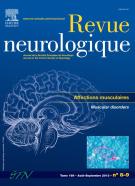 Muscle diseases may have various clinical manifestations including muscle weakness, atrophy or hypertrophy and joint contractures. A spectrum of non-muscular manifestations (cardiac, respiratory, cutaneous, central and peripheral nervous system…) may be associated. Few of these features are specific. Limb joint contractures or spine rigidity, when prevailing over muscle weakness in ambulant patients, are of high diagnostic value for diagnosis orientation. Within this context, among several disorders, four groups of diseases should systematically come to mind including the collagen VI-related myopathies, the Emery-Dreifuss muscular dystrophies, the SEPN1 and FHL1 related myopathies. More rarely, other genetic or acquired myopathies may present with marked contractures. Diagnostic work-up should include a comprehensive assessment including family history, neurological, cardiologic and respiratory evaluations. Paraclinical investigations should minimally include muscle imaging and electromyography. Muscle and skin biopsies as well as protein and molecular analyses usually help to reach a precise diagnosis. In this first series of articles, the authors describe the main muscle and neuromuscular junction diseases where contractures are typically a prominent symptom of high diagnostic value for diagnosis orientation. In the following chapters, they will present clues for the diagnostic strategy and the main measures to be taken when, at the end of the diagnostic work-up, no definite muscular disease has been identified.
Muscle diseases may have various clinical manifestations including muscle weakness, atrophy or hypertrophy and joint contractures. A spectrum of non-muscular manifestations (cardiac, respiratory, cutaneous, central and peripheral nervous system…) may be associated. Few of these features are specific. Limb joint contractures or spine rigidity, when prevailing over muscle weakness in ambulant patients, are of high diagnostic value for diagnosis orientation. Within this context, among several disorders, four groups of diseases should systematically come to mind including the collagen VI-related myopathies, the Emery-Dreifuss muscular dystrophies, the SEPN1 and FHL1 related myopathies. More rarely, other genetic or acquired myopathies may present with marked contractures. Diagnostic work-up should include a comprehensive assessment including family history, neurological, cardiologic and respiratory evaluations. Paraclinical investigations should minimally include muscle imaging and electromyography. Muscle and skin biopsies as well as protein and molecular analyses usually help to reach a precise diagnosis. In this first series of articles, the authors describe the main muscle and neuromuscular junction diseases where contractures are typically a prominent symptom of high diagnostic value for diagnosis orientation. In the following chapters, they will present clues for the diagnostic strategy and the main measures to be taken when, at the end of the diagnostic work-up, no definite muscular disease has been identified.
